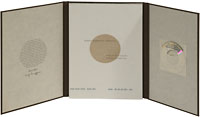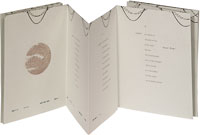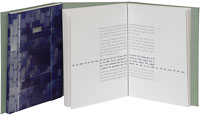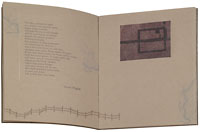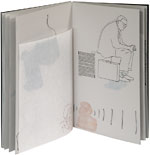The French Connection
Inge Bruggeman Asks All Those Existential Questions at INK-A! Press
By Richard Goodman
The late writer Mary McCarthy distinguished between “the novel of ideas” and “the novel of images.” If we were to apply this distinction to the world of fine presses, then surely the work of Inge Bruggeman and INK-A! Press falls into the former category. Her work thrives on ideas.
Inge Bruggeman was born and raised in California, near Los Angeles. After high school she spent two years in France where she studied French literature. She went to college at University of California/Santa Barbara, where her interest in the literature of France led her to take a course in livres d’ artistes. This was her epiphany. “The class was in the rare book department of the library,” she recalled. “I hadn’t known anything about this tradition! They let us touch these books, handle them. I loved that. I was hooked after that.” She also took classes from Harry and Sandra Reese of Turkey Press. (FB&C July/August 2008) Harry Reese founded the Book Arts Program at the University of California Santa Barbara. She then worked at Turkey Press for a while. And she became a printmaker.
Then it was off to the University of Alabama’s Book Arts program for a degree. When asked if Tuscaloosa was a culture shock for an urban Californian, Bruggeman answered, “Yes. But, you know, if I’d gone to school in New York, I’m sure I would have been distracted.” This might be a new recruiting angle for Alabama.
After Alabama, Bruggeman went to the Minnesota Center for the Book for a two-year residency. Then her old mentor Harry Reese called her home with a lecture job at UC Santa Barbara. She stayed for four years, and then moved to Portland, Oregon where she now lives and works and runs her two presses, INK-A! Press and Textura Letterpress Printing. The latter is for the works she is commissioned to do—i.e., it’s more commercially oriented. INK-A, which Bruggeman founded in 1992 when she was still a student at UC Santa Barbara, is for two kinds of works. She distinguishes between fine press books, which are centered around a writer’s text, and books in the livre d’artiste tradition, which focus more on her own printmaking and her own text.
The French influence on her work plays out less in the Manet and Picasso world of the visual than in the Camus and Sartre world of ideas. These are not so much beautiful books as they are thoughtful books. Yes, the books are well crafted and fine, and some of the printing—especially in a book like One of a Thousand Fires in which the impressions of the letters are bold and elegant and highly accomplished—is very impressive indeed. But after viewing and reading a book by Bruggeman, the eye is less stimulated than the brain. In fact, in all the books examined, the apotheosis of color is, though not precisely absent, certainly not of paramount interest to the artist. At least, you do not think, having read and perused these books, what amazing color! What color there is usually muted. There is also the feeling of just one color dominating these books: a tamed crimson in One of a Thousand Fires, a pale tan in Simple Harmonic Motions (2001), a haunting violet in Bad News.
So it seems the “message” of INK-A! is, above all, to make us think. And to challenge us. A book like Unable to Find Each Other, Let Alone Ourselves—Bruggeman’s most recent, published in 2007—steps right out of the world of Camus’ The Stranger, Sartre’s No Exit, or Beckett’s Waiting for Godot. Mostly faceless characters—all the artwork is by Bruggeman—“exist,” as she herself said, “within the same pages of the book, but are not able to connect or understand the repercussions their actions or gestures have on the others.” Textual commentary is woven in handwritten pencil script around the lonely figures with Jenny Holzer-like starkness and ambiguity, “Lost information can be reconstructed,” reads one, “tho’ gaps in meaning may persist.” Another reads, “Earlier experiments/mistakes were to be repeated on a far greater scale.”
You can clearly see this sense of alienation, or perhaps closer to the mark, this sense of being smothered, completely drowned, by modern life, in her book, Bad News (1998). The title is from a short story by Lynne Tillman that is within the book, but the story is accompanied by, not to say overshadowed by, photographs of clay sculptures that were created by Bruggeman. The sculptures have the look of something a spelunker might find after a descent of a thousand meters into a previously undiscovered cave; they are otherworldly in an ancient, chthonic way, some looking like menhirs that radiate an elusive meaning. The text, as Bruggeman said, reflects “the psyche of the main character who is disturbed by a constant radio voice feeding her fears.” “Alienation” is a word that inevitably rises to the surface when viewing Bruggeman’s work.








